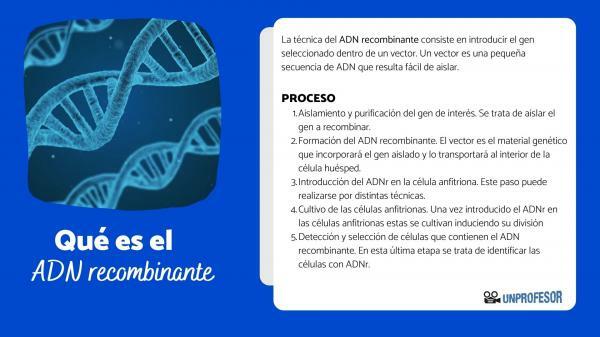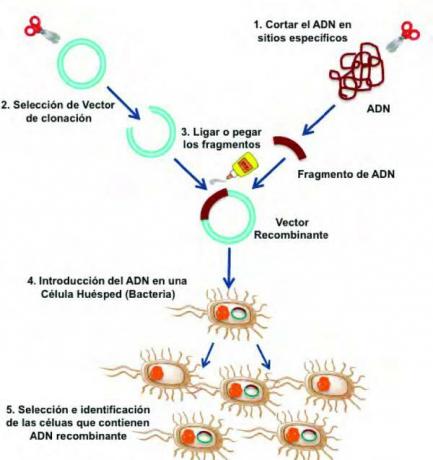Recombinant DNA: definition and process

The technique of Recombinant DNA (DNAr) is a technique used genetic engineering and that consists of creating in vitro of artificial DNA molecules in which genetic material from different species is combined. For this reason, the molecules thus obtained are called chimeric DNA or chimeras.
This technique forms the basis of biotechnology and genetic engineering and has multiple applications ranging from agriculture to biomedicine. For example, it allows the study of the expression of a certain gene, obtaining species plants showing resistance to certain pests or obtaining human insulin from sources animals.
In this lesson from a TEACHER we are going to show you the definition of recombinant DNA, what it is for and the process that is held. We will analyze all the stages so that you know better this genetic technique. We started!
The recombinant DNA technique consists of introducing the selected gene into a vector. A vector is a small sequence of DNA that is easy to isolate, such as a plasmid (Circular and extrachromosomal DNA typical of bacteria and other prokaryotic organisms).
The vector carrying the gene of interest is introduced into a host cell where it will be able to replicateindependently of cellular DNA.
What is recombinant DNA for?
Using the machinery of the host cell, the gene introduced by the vector will be expressed leading to the synthesis of the protein encoded by said gene. Furthermore, when the carrier cell replicates, the resulting cells will also contain said gene, thus creating a new genetically modified cell line.

Image: Research Gate
The stages of obtaining rDNA are as follows:
1- Isolation and purification of the gene of interest
In this first step, the aim is to isolate the gene to be recombined (for example, the gene for human insulin or a growth factor, etc.)
- Obtaining cellular DNA: For this, it is necessary for the DNA to release the DNA from the cells, which must be broken by cell lysis. When cells break, they release their genetic material (DNA) along with other molecules such as proteins or RNA, which is why it is necessary to isolate and purify the cellular DNA.
- Obtaining the isolated gene: Once the cellular DNA has been parified and concentrated, it is necessary to cut the DNA using restriction enzymes (very specific enzymes capable of breaking the DNA sequence at certain points). The action of suitable restriction enzymes liberates the gene that can be isolated by means of centrifugation or chromatography techniques.
2- Formation of recombinant DNA
The vector is the genetic material that incorporate the isolated gene and transport it inside the host cell.
The vector is usually a plasmid (circular DNA typical of prokaryotes), a virus or an artificially created chromosome, which must meet the following characteristics:
- It should be easy to isolate and small in size.
- It must contain sequences that are recognized by the factors of introducing the desired gene.
- It must be able to enter the host cell to replicate inside it independently of the cellular DNA.
- It must contain a genetic marker that allows it to be easily identified and isolated, such as an antibiotic resistance gene.
The stages There are two of this second phase of the recombinant DNA process:
- Cut the vector: Using the same restriction enzymes used to obtain the gene to be inserted, a cut is made in the vector DNA, leaving two ends of the DNA free.
- Insert the gene: The free ends caused by the action of restriction enzymes are the point where the previously isolated gene will be inserted in the first stage of isolation and purification of the gene. The union between the vector and the gene (which once introduced into the vector is called an insert), occurs by action of the enzyme ligase that catalyzes the covalent bond between the vector and the insert giving rise to the molecule of Recombinant DNA.
3- Introduction of rDNA into the host cell
This step can be done by different techniques such as altering by physicochemical means the permeability of the host cell membrane to allow the passage of rDNA, microinjection of rDNA using a micropipette, the introduction of rDNA into liposomes capable of fusing with the cell membrane to release its contents into the cell's cytoplasm Guest.
The host cells must be cells that reproduce very quickly, using either bacterial cells, yeast cells, or cancer cells.
4- Culture of host cells
Once the rDNA has been introduced into the host cells, they are are cultivated by inducing their division to obtain a large number of cells containing the rDNA. The cells are grown in Petri dishes that allow the isolation of colonies. which are subsequently grown in liquid media, thus obtaining a large number of clones (genetically identical cells ).
5- Detection and selection of cells containing recombinant DNA
In this last stage it is about identify cells with rDNA. To identify these cells, markers are used to detect the presence of rDNA. These Genetic markers can be diverse, an example would be the culture of the host cells in the presence of a antibiotic. When the antibiotic resistance gene present in the culture has been previously incorporated into the rDNA.

![PARASITE animals: classification + EXAMPLES!! [with photos]](/f/441c22146ffc7cb43b042bbf816a1f1d.jpg?width=300&height=200)

